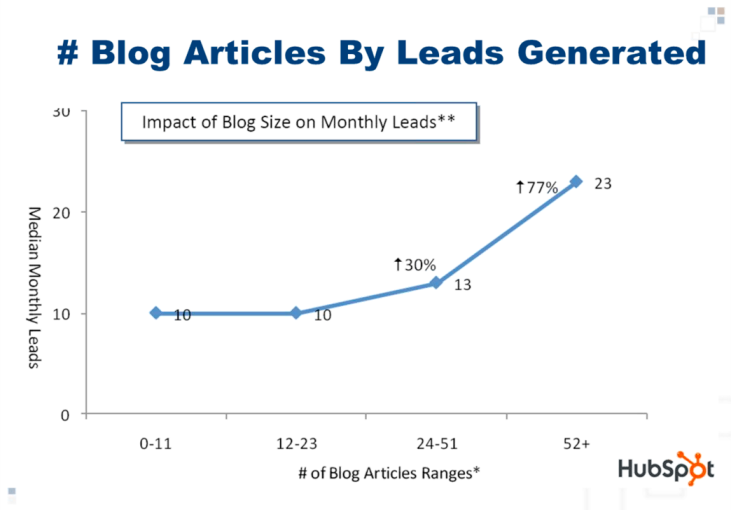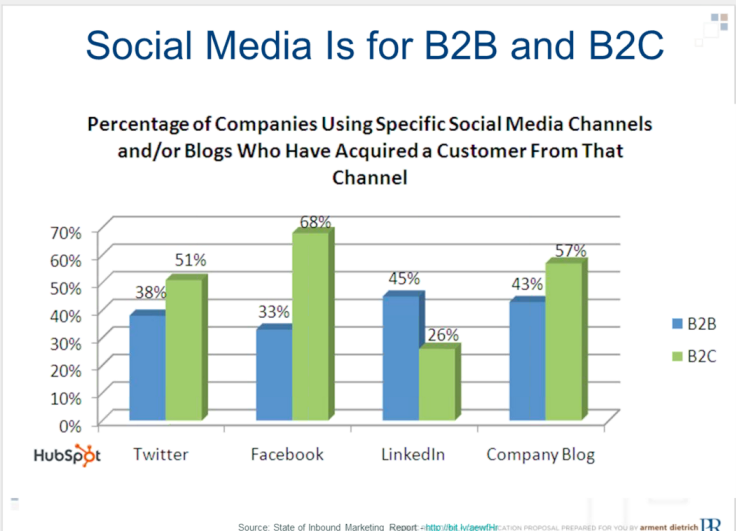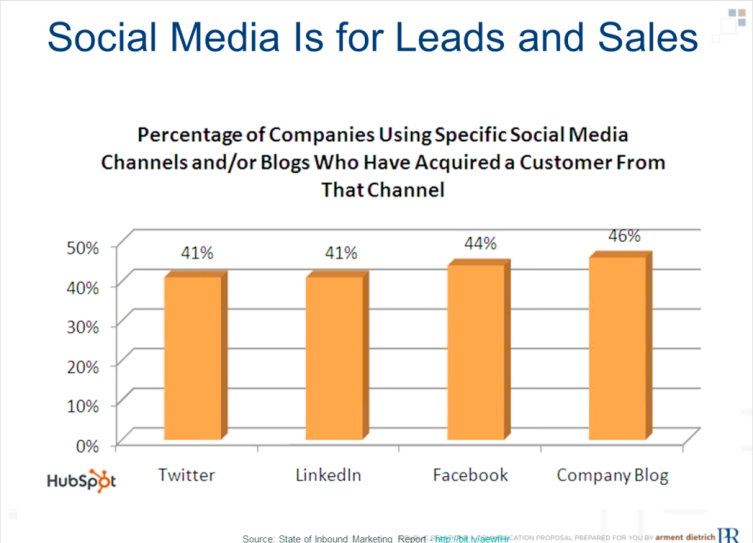Content Marketing for Beginners: Only What’s Free, Quick and Simple
Content Marketing 101: Only what’s free and easy to do
Last week, I jumped at the chance to join the “Marketing Metrics that Matter” webinar sponsored by Group High outreach marketing software, led by Gini Dietrich of the infamous Spin Sucks — those guys who were doing online content marketing and branding way before it was hot (way back in ’96 when the “Macarena” was hot.) The webinar was an easy-to-follow tutorial on how to use content marketing online to spread your brand on the cheap, but was more for the marketing crowd who is trying to break more into web. So today we’re mixing Gini’s awesome experience with our more humble roots, stripping all that information down to the brass tacks, and created a bunch of tips to help prepare you to start growing your brand online through content marketing today!
Deal with it: Your company needs a website, a blog, social media
Why is that? Because, by the end of 2013, there will be more active smartphones than people on earth. Your company has to be a part of that.
Yes, we know you don’t have time for all those things, but, first, if you don’t have these things, you’re considered, in this day and age, just plain odd or suspicious. And you’ll be missing out because, chances are, your competitors will have all this and more. Plus, it’s free marketing — or just the cost of a web domain and a couple focused hours a week — so why wouldn’t you?
Let’s start with why you just gotta have a blog…
“Don’t think of it as blogging, think of it as content,” says Gini, and then think of it as lead generation. She cites the stats that if you blog regularly, on topics that your clients care about, each month your business will increase:
- If your business sells to the Consumer (B2C,) blogging will give you an increase of seven percent of leads
- If your business sells to Another Business (B2B,) you will see a whopping increase of 67 percent in lead generation!
If you created one piece of new content every week, you’d increase leads from your blog by 77 percent. But remember, quantity doesn’t necessarily mean quality. Spin Sucks, like us at Quote Roller, has moved from posting every weekday to three times a week. Both of us have moved to longer, higher quality pieces.
Of course, blogging isn’t an automated brainless activity. You need to know your target customers. This comes from asking them open-ended questions to learn really and truly what their needs are. Your blog is just another aspects of your Socratic needs-based selling. (You know, that proven sales method that hasn’t really been best in two millennia.)
Content marketing via your blog is about establishing your company as a helpful expert in your arena. What questions did you have when you started out or do your customers have? What are the hot tests topics in your field? Make sure to write about what your business does. Another great thing is to enable commenting and ask a lot of open-ended questions to further the discussion, as well as to collect essential feedback on your product or service. (Plus, it’ll make your blog piece all the rage on Google.)
One trick Spin Sucks does — that I, as a content manager, adore — is to assign topics to employees in their specialization once or twice a month. For Quote Roller, we have so many fantastic designers and developers on our team and you, our bread and butter, is more likely to be in that sector than any other. I love the idea of our guys and your guys trading secrets. (And we all know I shouldn’t writing about anything too technical…)

And now, behold, the value of social media
Social media are free ways to attract attention and fans to your product or service. Social media is important in creating brand awareness.
Facebook is essential if you run a B2C, a business that sells directly to the consumer. If it were a country, Zuckerberglandia’s population would fall just behind India’s — you just have to be a part of that. It’s highly likely that, before making a purchase, a consumer will Google you or search for you on Facebook. If they “like” you on Facebook, they are then highly likely to share that “like” with their friends. Facebook and Twitter followers become advocates for your brand and at no cost to you.
For B2B transactions, other businesses will search for you, most likely, on LinkedIn. They want to see if any of their professional connections are connected with your brand and they want to see if anyone has reviewed you or if you’ve been in the news. Also, if you provide a service and have a team, LinkedIn becomes the CV/resume and recommendation stopping point that sells your team’s experience.
Social media is also where folks go more and more often for tech support, so, once you set up your various social networks, make sure to have someone checking it regularly, preferably at least once a work day, however, with the increasing popularity of these networks, patience has decreased dramatically, and, if you don’t respond within an hour, you may have a Tweet Avenger on your hands.

And, finally, that all-important website
If you’ve noticed, we go through and try to follow as many of our clients on social media as possible. This process involves me going to sometimes hundreds of client websites a day. As it turns out, in my humble estimation, I’d say about 30 percent of our clients don’t have websites at all — or at least emails with website domains — and about five percent of those that do have sites don’t really — they are instead perpetually “under construction,” lacking even the most basic of contact info. At least a quarter may have social network buttons, but their “T”, “F”. “P” and “LI” buttons do not lead to those pages. Bare minimum, your website should have a field in which clients can contact you, find your contact info, links to your social media and something about your company — perhaps your speciality, experience and maybe a photo or two of your team or of your product or visually pleasing service.
Having a solid website dramatically decreases your advertising spend. In the webinar, Gini refers to one company that her Internet marketing agency helped put on the e-map. River Pools & Spas is a pool company that used the Internet to stand out from the other pool retailers — and now it enjoys the benefits of having the highest search result for the segment of the industry. The company worked to create content that helps answer the question: “Considering an inground pool?” The website focuses on content that attracts leads, striving to outline all the options and answer every question, from fiberglass versus tile to pool size and shape.
By creating that website, Gini says that River Pool & Spas, who used to publish in a lot of directories and print ads, reduced ad costs by 70 percent, tripled their website traffic, and quadrupled their organic leads. But there was still more they could do…
But how do I turn all that into sales?
Yes, an informative page is a nice thing to offer your customers, but it’s wasteful (at least in time) for your business without calls to action (CTA.) Your blog and social media should lead back to your website and all your content should lead to sales. Don’t be afraid to ask for things, like:
- including a sign up for a newsletter or more info
- a sales quote request form
- a button that reads, “Click here to try out our product/service” or “Buy it today”
- or even make them log in the first time they want to access your blog, so you capture that info
Your blog can be short posts, long posts, white paper, or simply the quick, easy and free landing page for your whole company, but you have to make sure it asks the reader to do something that will increase the likelihood that the reader turns into a qualified sales lead.
Continuing with the aforementioned example, River Pools had created a great website that offered a lot of information to their customers and potential customers and brought the business a lot of brand recognition and to the top of the Google results. They also reduced ad costs and increased their online presence across multiple platforms by a mile, but they were missing one key step — brand ambassadors. Sometimes a CTA is simply properly including working share buttons linking to social media — that good old “You like us? Now tell your friends!” idea. Gini recommends particularly the scroll-down-the-side share buttons (like we have here,) which kick in about halfway through any piece of blog or website content and remind the reader to take a mere second to share that info. Remember, we still trust first-hand friends and family opinions way, way, way more than traditional advertising, they just might be sharing a lot more of them on the Internet.

Tips to win with All-Powerful Google, the Wonderful Wizard of Web
Those of us in content marketing spend a lot of time talking about SEO — search engine optimization — when really we could just call it Googleability because like Henry Gale, Google is all powerful. So to end this learn-content-marketing-in-ten-minutes-flat tutorial, we offer you a few more quick tips:
- For blogs and websites, Google likes more than a thousand words and really likes more than 2,000 words
- Google and humans like more consumable content, like bullets and bite-sized facts pulled out
- Google (and humans) like images, but saved correctly. For Quote Roller, sometimes we need to use screenshots. We don’t save them as the automatically “Screenshot 4, August 15, 2012,” but rather save as “Quote-Roller-business-proposals” (It’s details like this that can make you a #1 Google result!)
- Google loves social media, especially its less-popular but most powerful namesake GooglePLUS. Simply clicking “+1” on your piece gives it a bump in the search engine.
- Google also really likes Facebook, so make sure to invite your friends and family to start liking and sharing your page and its content. That sharing will eventually snowball into something bigger.
Now, Google also really loves keywords — but human beings like them significantly less. It’s important for Googleability to use the same key word or phrase in:
- catchy headlines, often starting with # Tips/Tricks to or How to…, like “How to write a business proposal like a pro”
- then a shorter catchy Google search snippet headline, like “How to write a business proposal” (max. 70 characters)
- a short URL, with words connected like: blog.quoteroller.com/business-proposal-guide
- in the meta description, which is that dek or blurb that entices the Googler to click, “Relax and learn to write a professional business proposal that’s sure to be signed.” (max. 156 characters)
- the body of the text, which should include the exact keyword phrase six to eight times, more depending on length of piece
- EXTRA TIP: Don’t cram the keywords down your prospects’ throats — if it doesn’t flow naturally, they’ll quickly catch on and click off
So what’s all this come down to?
In the web-based world we live in, you and your brand must be present — in fact, you must at least put in a modicum of effort for it to stand out. Now, with this quick-and-easy content marketing guide, you can jump right in or just get your toes wet, but start leaving your cyber footprint in the sand today.
So, what are your content marketing secrets? Spill!
All photos and graphs are screenshots I took from the “Marketing Metrics Matter” webinar by Spin Sucks.
Comments